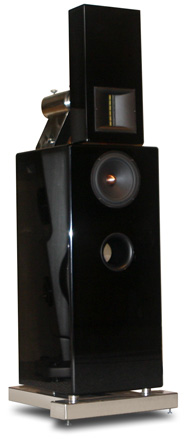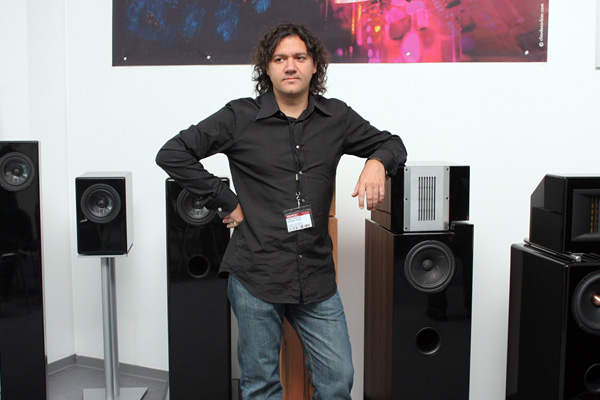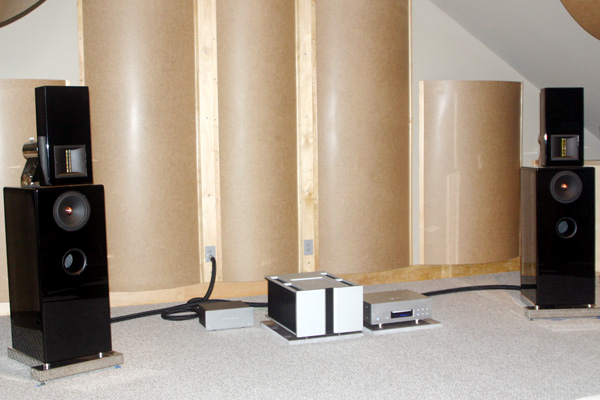 |
|||
| September 1, 2007 Searching for the Extreme: Jürgen Scheuring of Ascendo
Design principles Scheuring initially listed several design elements he incorporates into his loudspeakers. One of his first considerations is time alignment -- each driver’s output arriving at the listener’s ear at precisely the same moment in time. Several speaker manufacturers tout time alignment, or proper group delay, or phase coherence, so this alone does not set Ascendo speakers apart. I would come to learn that time alignment is only one key to their originality. One of Scheuring’s first statements summed up this complex loudspeaker issue: "Perfect time-domain behavior … some call it impulse response, some step response, others phase -- it is all the same: Every frequency has to arrive exactly at the same time at your ear." Sounds simple enough, but those who have studied available loudspeaker models that accomplish this goal while also performing well in other technical parameters will realize just how difficult the balancing act must be. Time alignment is not the only technical characteristic that Scheuring believes accounts for the sound quality he achieves. He also said that his speakers have "fast risetime and fast decay times in the high, mid, and the low end, and very low high-order distortions. When these are achieved, the listener can expect very good imaging and spaciousness." Risetime, measured in microseconds (µs), is the ability of a speaker or electronic component to respond to an electrical signal. Manufacturers often equate this measurement with a component’s ability to sound quick and agile. I was curious about the bass-loading method Scheuring uses -- the woofer in the System M-S is mounted internally, with only a front-mounted port visible -- and how it affects time alignment. In a time-aligned speaker, you often see all of the drive elements’ voice-coils lined up on a raked-back, or stepped front baffle. Scheuring said that "Ascendo speakers have perfect time alignment down to around 80Hz. The bass driver produces a slightly higher group delay below this frequency. This is taken into account with the S.A.S.B. unit. It matches the phase in the transition region between mids and lows in such a way that there is no audible acoustical break." Time alignment is not just a matter of how the drive-units are positioned in and on the cabinet, however. The crossover slopes, too, are critical. I asked Scheuring about his crossovers and how they help accomplish the goal of time alignment. First, he pointed out that, above about 90Hz, his speakers act as simple two-way designs, actually simplifying the crossovers. "We use as few ways as possible because every way you add has latency, and affects the time behavior. Time alignment is not only a question of the highs and mids, but also of the very low end. Every way you add to your design affects your alignment. There is a basic tradeoff when using conventional crossover designs: 6dB/octave types preserve phase and yield good time behavior but have very bad damping in the sidebands. This problem limits the dynamics and headroom of the speaker substantially."
So if the crossover slopes are not 6dB/octave designs, what are they? In the Ascendo marketing literature, the term Constant Voltage Kernel appears. What, exactly, does that mean, particularly as it affects time alignment? Scheuring: "High-order designs (18-24dB/octave) have good sideband damping but damage time behavior. Ascendo has developed a new technology that overcomes these problems. We use a unique design of a Constant Voltage Kernel embedded in an 18dB/octave filter. This special design gives us very good phase and time behavior in the crossover region (similar to 6dB/octave designs), while we have huge damping (over 30dB/octave) in the sidebands. A Constant Voltage Kernel is a special four-part crossover design where three parts of the network are capacitors and inductors (depending on the type of filter) and the fourth part is the driver itself." OK, so back to the S.A.S.B. (semisymmetrical bandpass dynamic current-damped woofer) bass alignment. I was curious as to how this method differs from more conventional bass-loading alignments, such as a sealed or ported box. Scheuring elaborated: "There are two basic low-frequency designs on the market: bandpass and vented enclosures. The problem with a bandpass design is, in principle, that it is too slow [in the time domain]. It normally produces very deep and fast bass, but it is, in the time domain, not aligned with the midrange. The problem with a vented design is that there is no acoustic damping of the speaker for frequencies lower than the tuning frequency. That often slows down the low-end reproduction. "With our patented S.A.S.B. unit, these problems are solved. There is a speaker for the (low) mid in a very small closed volume, and a design that looks similar to a bandpass for the low end. The trick is to design the impedances of these two speakers, including the crossover and box volumes, such that: 1) they are (electrically) damping each other, and 2) there is no acoustical break in the crossover range (at about 90Hz). The effect is that you have the advantages of both systems: You have a very fast and deep low-end reproduction, and it is time-aligned with the lower mids. Further, you get really deep bass (lower than 30Hz) from a relatively small enclosure. This also allows us to use far smaller bass drivers with less moving mass. This yields extremely fast bass response." Other attributes If you believe that speakers should re-produce sound while not producing any of their own -- the real goal of a high-fidelity audio system, in my estimation -- then many factors must be optimized if the design is to contend for the state of the art. When asked about distortion and cabinet resonances, two technical problems that can damage a speaker’s ability to accurately reproduce the input signal, Scheuring said, "A lot of speakers are well designed in the linear domain (amplitude and phase). To achieve real high-end performance you have to do more: you must take care with the nonlinearities. The trick is to balance linear and nonlinear parameters in the best way. This means that you have both to measure and listen a lot while you are designing the speaker." Cabinet vibrations, and how one cabinet module affects another, are also considered: "To avoid coupling of speaker vibrations, we did the consequent stand design: The low-frequency unit is coupled on three well-defined points to the stand (the idea is from bridge architecture). So there is a very small impact of vibrations to the stand. Very few of these vibrations are coupled to the floor. And even fewer are going to the high-frequency unit: The HF unit is designed with a very heavy stainless-steel cylinder with a very low resonance frequency (it’s the simple physics of coupled pendulums)." Finally, for you heavy-metal types, there is a speaker’s ability to play loud: "We have tested the System M-S with peak power of 1kW and the System Z with 650W. There was no damage. That’s what a customer can expect for his money. Nevertheless, the System M-S and System Z will work at very low levels, too, with the same high-end performance! There is no need for monster amplification. You can use 10W tubes with no problem."
In summary Scheuring pointed out that the technical benefits of his designs are best realized in the listening. I agree. There’s little point in achieving a technical goal if the end result isn’t a better listening experience. According to Scheuring, here is what you should expect to hear from an Ascendo design: "Due to the time alignment [capability] and the adjustment for the listener’s position, the Ascendo speakers produce a time-coherent signal. Sonically, this means an authentic reproduction, especially of strings (piano, viola, guitar, etc.), and a great three-dimensional soundfield (not only left/right but also front/rear). The Ascendo speakers also have outstanding resolution in the high-frequency range, so really complex material, such as big orchestras, are reproduced very detailed. Due to the patented S.A.S.B. bass technology, the Ascendo speakers have both very deep and very fast reproduction at the low end. Further, there is absolutely no discontinuity between the midrange soundfield and the low-end response." I’m putting Jürgen Scheuring’s sonic claims to those tests. In "The World's Best Audio System" you can read about my impressions of the Ascendo System M-S loudspeaker system, as auditioned in my Music Vault listening room. ...Jeff Fritz To learn more about Ascendo's products, please visit www.ascendo.de.
Ultra Audio is part of the SoundStage! Network. |


